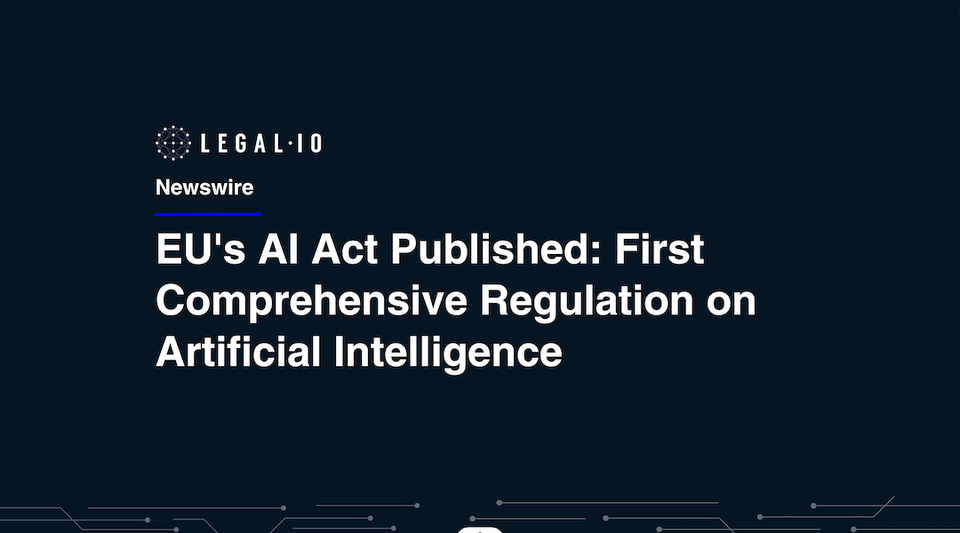One of our members wrote about this subject! Check out their post here!
The European Union has officially published its groundbreaking Artificial Intelligence (AI) Act in the EU Official Journal on July 12, 2024. This landmark legislation, set to enter into force on August 1, 2024, represents the EU's most comprehensive attempt to regulate AI technologies and establish a framework for their ethical and responsible use. The AI Act is poised to shape the development and deployment of AI across Europe, with far-reaching implications for businesses, consumers, and the global AI landscape.
The AI Act: A Brief Overview
The AI Act is designed to address the myriad challenges and risks associated with AI technologies while fostering innovation and ensuring the EU remains at the forefront of AI regulation. The legislation introduces a risk-based approach to regulation, categorizing AI systems based on their potential impact on safety and fundamental rights.
Key Provisions
1. Risk Classification: The Act classifies AI systems into four categories: unacceptable risk, high risk, limited risk, and minimal risk. Systems deemed to pose an unacceptable risk, such as social scoring by governments, are outright banned. High-risk systems, including those used in critical infrastructure, education, employment, and law enforcement, face stringent requirements and oversight.
2. High-Risk AI Systems: These systems must comply with strict requirements regarding data quality, transparency, and human oversight. Providers of high-risk AI systems will need to implement risk management systems, maintain documentation for regulatory bodies, and ensure their systems are robust, accurate, and secure.
3. Transparency Obligations: AI systems interacting with humans, generating deep fakes, or making decisions that significantly impact individuals must be transparent about their nature. Users should be informed that they are interacting with an AI system and be given clear explanations of its capabilities and limitations.
4. Governance and Oversight: The Act establishes a European Artificial Intelligence Board to facilitate cooperation among member states and ensure consistent application of the regulations. National supervisory authorities will be responsible for monitoring compliance and enforcing the rules.
5. Codes of Conduct and Sandboxes: The Act encourages the development of codes of conduct and regulatory sandboxes to foster innovation while ensuring compliance. These sandboxes will provide a controlled environment for testing AI systems under the supervision of regulatory authorities.
Implementation Process and Next Steps
With the AI Act set to enter into force on August 1, the EU and its member states will embark on a detailed implementation process. Here are the key next steps:
-
Prohibited AI practices to be withdrawn from the market by February 2, 2025
-
Codes of practice to be developed by May 2, 2025
-
General purpose AI (GPAI) models will be in compliance by August 2, 2025. Governance structure (AI Office, European Artificial Intelligence Board, national market surveillance authorities, etc.) will have to be in place.
-
European Commission will adopt an Implementing Act, which lays down detailed provisions that establish a template for the post-market monitoring plan and the list of elements to be included in the plan, by February 2, 2026
-
All rules of the AI Act become applicable as of August 2, 2026, including obligations for high-risk systems, Member States shall ensure that their competent authorities have established at least one operational AI regulatory sandbox at national level.
-
Obligations for high-risk systems will apply as of August 2, 2027
Impact on Businesses and Consumers
The AI Act will have significant implications for businesses developing and deploying AI technologies. Companies offering high-risk AI systems will face new compliance costs and operational challenges as they adapt to the stringent requirements. However, the Act also provides opportunities for businesses to innovate responsibly and gain consumer trust.
By adhering to the AI Act, companies can demonstrate their commitment to ethical AI practices, potentially gaining a competitive advantage. The establishment of regulatory sandboxes will also help businesses test and refine their AI systems, fostering a culture of innovation within a regulated framework.
The AI Act aims to enhance consumer protection and trust in AI technologies. By imposing transparency requirements and banning systems with unacceptable risks, the Act hopes to ensure consumers are informed and safeguarded against potential harms associated with AI. This increased transparency will enable consumers to make more informed decisions and feel more secure when interacting with AI systems.
Global Implications
The AI Act positions the EU as a global leader in AI regulation, potentially setting a precedent for other regions to follow. As countries around the world grapple with the challenges posed by AI, the EU's regulatory framework could serve as a model for balancing innovation with ethical considerations and consumer protection.










